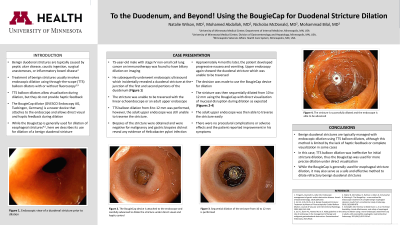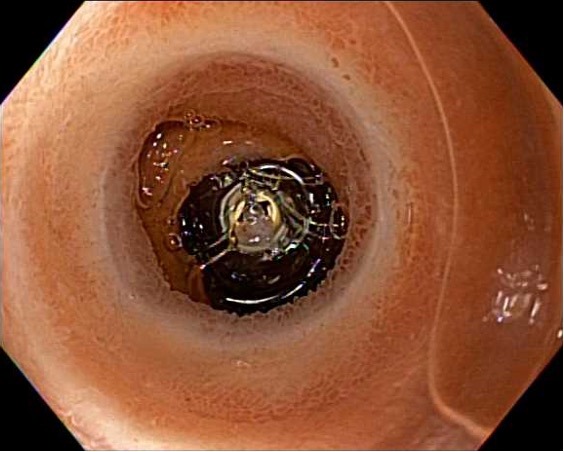Back


Poster Session D - Tuesday Morning
Category: Interventional Endoscopy
D0466 - To the Duodenum, and Beyond! Using the BougieCap for Duodenal Stricture Dilation
Tuesday, October 25, 2022
10:00 AM – 12:00 PM ET
Location: Crown Ballroom

Has Audio
.jpg)
Natalie Wilson, MD
University of Minnesota
Minneapolis, MN
Presenting Author(s)
Natalie Wilson, MD1, Mohamed Abdallah, MD2, Nicholas McDonald, MD1, Mohammad Bilal, MD3
1University of Minnesota, Minneapolis, MN; 2University of Minnesota Medical Center, Minneapolis, MN; 3University of Minnesota, Minneapolis VA Medical Center, Minneapolis, MN
Introduction: Benign duodenal strictures are typically caused by peptic ulcer disease, caustic ingestion, surgical anastomoses, or inflammatory bowel disease. Treatment of benign strictures usually involves endoscopic dilation using through-the-scope (TTS) balloon dilators with or without fluoroscopy. TTS balloon dilators allow visualization during dilation, but they do not provide haptic feedback. The BougieCap dilator is a newer device that attaches to the endoscope and allows direct visual and haptic feedback during dilation. While it is generally used for dilation of esophageal strictures, this report describes its use for dilation of a benign duodenal stricture.
Case Description/Methods: A 75-year-old male with stage IV non-small cell lung cancer on immunotherapy was found to have biliary dilation on imaging. He subsequently underwent endoscopic ultrasound which incidentally revealed a duodenal stricture at the junction of the first and second portions of the duodenum. The stricture was unable to be traversed with the linear echoendoscope or an adult upper endoscope. TTS balloon dilation from 8 to 12 mm was performed, however, the adult upper endoscope was still unable to traverse the stricture. Biopsies of the stricture were obtained and were negative for malignancy and gastric biopsies did not reveal any evidence of Helicobacter pylori infection. Approximately 4 months later, the patient developed progressive nausea and vomiting. Upper endoscopy again showed the duodenal stricture which was unable to be traversed. The decision was made to use the BougieCap device for dilation. The stricture was then sequentially dilated from 10 to 12 mm using the BougieCap with direct visualization of mucosal disruption during dilation as expected (Figure 1). The adult upper endoscope was then able to traverse the stricture easily. There were no procedural complications or adverse effects and the patient reported improvement in his symptoms.
Discussion: Benign duodenal strictures are typically treated with endoscopic dilation using TTS balloon dilators, although this method is limited by the lack of haptic feedback or complete visualization in some cases. In this case, TTS balloon dilation was ineffective for initial stricture dilation, thus the BougieCap was used for more precise dilation under direct visualization. While the BougieCap is generally used for esophageal stricture dilation, it may also serve as a safe and effective method to dilate refractory benign duodenal strictures.

Disclosures:
Natalie Wilson, MD1, Mohamed Abdallah, MD2, Nicholas McDonald, MD1, Mohammad Bilal, MD3. D0466 - To the Duodenum, and Beyond! Using the BougieCap for Duodenal Stricture Dilation, ACG 2022 Annual Scientific Meeting Abstracts. Charlotte, NC: American College of Gastroenterology.
1University of Minnesota, Minneapolis, MN; 2University of Minnesota Medical Center, Minneapolis, MN; 3University of Minnesota, Minneapolis VA Medical Center, Minneapolis, MN
Introduction: Benign duodenal strictures are typically caused by peptic ulcer disease, caustic ingestion, surgical anastomoses, or inflammatory bowel disease. Treatment of benign strictures usually involves endoscopic dilation using through-the-scope (TTS) balloon dilators with or without fluoroscopy. TTS balloon dilators allow visualization during dilation, but they do not provide haptic feedback. The BougieCap dilator is a newer device that attaches to the endoscope and allows direct visual and haptic feedback during dilation. While it is generally used for dilation of esophageal strictures, this report describes its use for dilation of a benign duodenal stricture.
Case Description/Methods: A 75-year-old male with stage IV non-small cell lung cancer on immunotherapy was found to have biliary dilation on imaging. He subsequently underwent endoscopic ultrasound which incidentally revealed a duodenal stricture at the junction of the first and second portions of the duodenum. The stricture was unable to be traversed with the linear echoendoscope or an adult upper endoscope. TTS balloon dilation from 8 to 12 mm was performed, however, the adult upper endoscope was still unable to traverse the stricture. Biopsies of the stricture were obtained and were negative for malignancy and gastric biopsies did not reveal any evidence of Helicobacter pylori infection. Approximately 4 months later, the patient developed progressive nausea and vomiting. Upper endoscopy again showed the duodenal stricture which was unable to be traversed. The decision was made to use the BougieCap device for dilation. The stricture was then sequentially dilated from 10 to 12 mm using the BougieCap with direct visualization of mucosal disruption during dilation as expected (Figure 1). The adult upper endoscope was then able to traverse the stricture easily. There were no procedural complications or adverse effects and the patient reported improvement in his symptoms.
Discussion: Benign duodenal strictures are typically treated with endoscopic dilation using TTS balloon dilators, although this method is limited by the lack of haptic feedback or complete visualization in some cases. In this case, TTS balloon dilation was ineffective for initial stricture dilation, thus the BougieCap was used for more precise dilation under direct visualization. While the BougieCap is generally used for esophageal stricture dilation, it may also serve as a safe and effective method to dilate refractory benign duodenal strictures.

Figure: Figure 1. Endoscopic image of BougieCap dilation of the duodenal stricture
Disclosures:
Natalie Wilson indicated no relevant financial relationships.
Mohamed Abdallah indicated no relevant financial relationships.
Nicholas McDonald indicated no relevant financial relationships.
Mohammad Bilal indicated no relevant financial relationships.
Natalie Wilson, MD1, Mohamed Abdallah, MD2, Nicholas McDonald, MD1, Mohammad Bilal, MD3. D0466 - To the Duodenum, and Beyond! Using the BougieCap for Duodenal Stricture Dilation, ACG 2022 Annual Scientific Meeting Abstracts. Charlotte, NC: American College of Gastroenterology.
